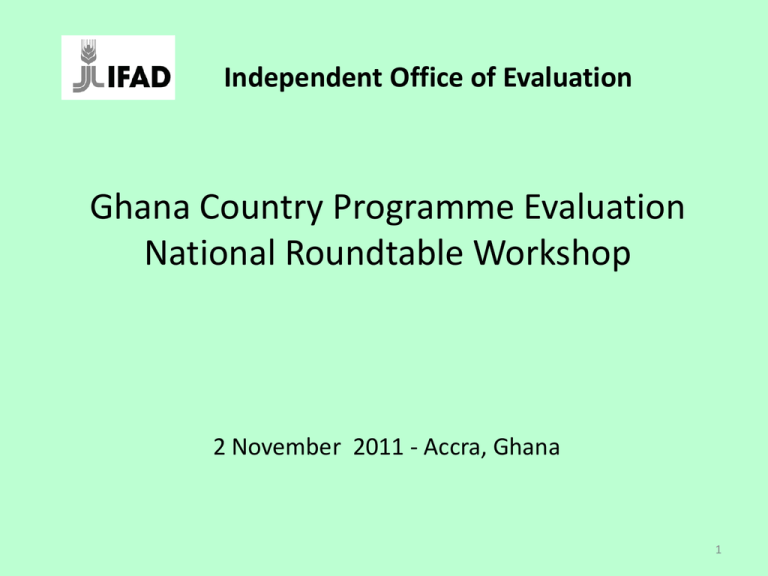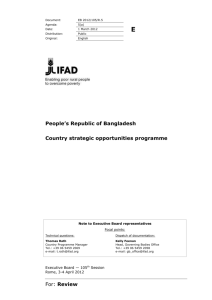Independent Office of Evaluation
advertisement

Independent Office of Evaluation Ghana Country Programme Evaluation National Roundtable Workshop 2 November 2011 - Accra, Ghana 1 Ghana Country Programme Evaluation • Covers 13 years of strategy and operations (COSOP 1998, 2006), 6 projects and 9 technical assistance grants • Triangulates from multiple sources: Comprehensive desk review (including past evaluations); Field visits of projects and selected grants Interviews with stakeholders Thematic roundtable discussions (rural finance, agricultural value chains) 2 Three levels of analysis Performance of the COSOP (strategy) Performance of non-lending activities (knowledge management, partnerships, policy dialogue) Overall Partnership Performance Performance of the portfolio (project-level analysis) 3 IFAD- Ghana Cooperation Highlights Total projects : 16 (since 1980) Total cost: US$ 675 m IFAD lending: US$ 225 m h.c. loans (33%) Gov. funding: US$ 162 m (24%) Co-financing US$ 288 m (43%) 4 Real GDP per capita in Ghana (1972-2010) constant 2000 US$ GDP per capita (data from 2006 follow the rebasing proposed by Ghana Statistical Service) 400 350 300 250 200 150 100 50 Source: WB 2011 20 08 20 06 20 04 20 02 20 00 19 98 19 96 19 94 19 92 19 90 19 88 19 86 19 84 19 82 19 80 19 78 19 76 19 74 19 72 0 5 Prevalence of Poverty (%) 88 88 90 80 63 70 60 67 70 52 52 50 40 1991/92 29 30 2005/06 20 10 0 National Northern Upper West Upper East 6 Evolution of IFAD’s strategy COSOP 1998 - Geographic concentration on regions in Northern Ghana - Sub-sectors: irrigation, rural finance, agricultural technology transfer, support to decentralisation COSOP 2006 - Shift towards country-wide mono-sectoral programmes (phasing out of Upper West) - Same subsectors + new focus on value chain development Other important changes • IFAD Direct supervision since 2008 • IFAD Country presence since 2011 7 Portfolio Performance – Overview • Overall positive and improving • Relevant project objectives, some design flaws • Effectiveness varies within and between projects • Weak efficiency • Impact is mixed: strong on institution and social capital, variable for income & assets; environmental risks • Sustainability is improving • Innovations introduced but piloting not sufficient. 8 Portfolio performance - Rural Finance • Relevant and effective at institutional level (regulatory environment, rural banks, credit unions, apexes) • Less so at adapting financial products to rural poor clients • Introduced “matching grants” as smart subsidies (loan + equity + ma. grant) ; lack of clarity over implementation • Contributed to national policy on microfinance (but subsidised credit programmes continue) 9 Portfolio performance - Rural Enterprises • Business Assistance Centres imparted basic entrepreneurial skills, contributing to growth of micro and small enterprises • Rural Technology Facilities strengthened apprenticeship systems, less clear results in technology dissemination • Facilitated coordination and public-private partnership in MSE development at district level (legislative initiatives) 10 Portfolio performance - Local Government and Community Development • Focused on very poor groups, supporting district-level participatory planning • Design too optimistic: (i) unclear policy framework (ii) IFAD not supported by experienced development partners; (iii) funding gap Slow implementation and sustainability threats 11 Portfolio performance - Agricultural development • Effective at supporting production : (i) higher-yield roots and tubers; (ii) participatory extension approaches (farmers field fora) • Value chain support: relevant but difficult to implement. Weak business analysis, unclear mutual obligations in private-public partnerships Upgrading processing for existing value chains (roots & tubers); Development of new value chains is challenging (e.g. vegetables) 12 “Non-lending” activities • Policy dialogue: significant in rural enterprise; rural finance. Matching grants have potential. Limited in other sub-sectors • Partnerships strong with Government at national level, growing at local level. In rural finance, gap with multilateral agencies Value chain: increasing with private sector, but review of risks and constraints not sufficient • Knowledge management is weaker area: poor M&E, impact assessment. Promising “intuitions” in COSOP and project formulation not always supported by technical analysis 13 COSOP performance • Relevance. Shift of focus between 1998 and 2006 COSOP from geographic targeting to broad-based growth with limited analysis of implications and constraints • Effectiveness. Strongest results in rural finance and rural enterprises at institutional level Mixed results in the North Value chains: valid concept, early implementation stage, questions on approaches • Management issues. Country office established in 2011. M&E has not received enough attention 14 General Assessment COSOP performance Moderately Satisfactory: 4 Non-lending activities Moderately Satisfactory: 4 Overall Partnership Performance Moderately Satisfactory: 4 Performance of the portfolio Moderately Satisfactory: 4 Rating scale: 1 = highly unsatisfactory; 2 = unsatisfactory; 3 = moderately unsatisfactory; 4 = moderately satisfactory; 5 = satisfactory; 6 = highly satisfactory 15 Main Recommendations • Strengthen analytical work in COSOP preparation and project design • Continue sub-sectoral programmes but increase focus on Upper West • More emphasis on testing and scaling up innovations: (i) rural finance and matching grants; (ii) savings and credit products adapted to the poor • Value chains. Review successful regional experiences, explore opportunities to cooperate with other initiatives • Support national M&E systems in partnership with national and international social science research institutions 16 THE END Thank you for your attention 17









